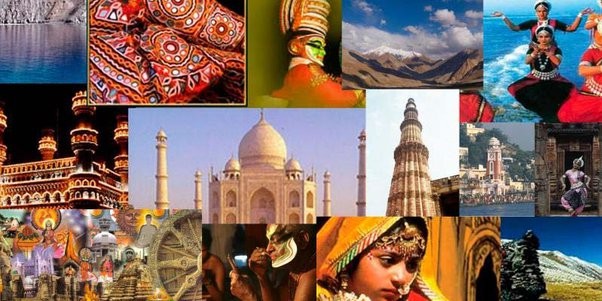What is The Capital of India: History, Facts, Best Places to See
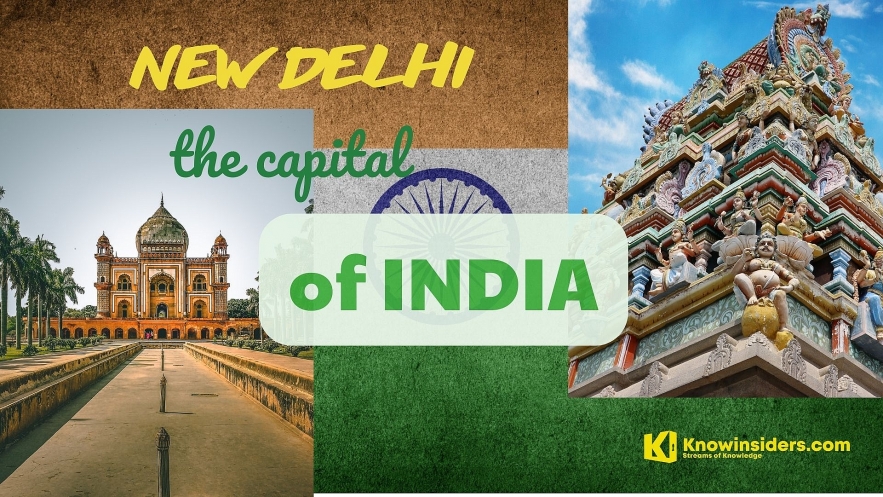 |
| What Is The Capital of India: History, Facts, Best Places to See. Photo: knowinsiders. |
What is the Capital of India?
How much do you know about India? Let’s start with the basics, including history, best places to go and frequently asked questions and facts about the capital of India.
Delhi is India’s capital city and one of the oldest in the world. Located in the north, it’s home to all three branches of the government: executive, legislative and judiciary. Delhi, the capital of India has a strong historical background. It was ruled by some of the most powerful emperors in Indian history.
*****
History of New Delhi
The history of the city is as old as the epic Mahabharata. The town was known as Indraprastha, where Pandavas used to live. In due course eight more cities came alive adjacent to Indraprastha: Lal Kot, Siri, Dinpanah, Quila Rai Pithora, Ferozabad, Jahanpanah, Tughlakabad and Shahjahanabad.
According to delhitourism, Delhi has been a witness to the political turmoil for over five centuries. It was ruled by the Mughals in succession to Khiljis and Tughlaqs.
The glorious and tumultuous history of Delhi is 5000-year-old. The history of Delhi begins with the formation of Indraprastha by the Pandavas and its subsequent conversion into a tranquil retreat. Several royal citadels such as the Indraprastha, Lal Kot, Quila Rai Pithora, Siri, Jahanpanah, Tughlakabad, Ferozabad, Dinpanah, and Delhi Sher Shahi (formerly Shahjahanabad) of various kings and emperors combine and integrate into one city that is always called Delhi. Thus, Delhi has always been identified for its power and imperial influence.
The ancient Purana Qila and the eternal Jamuna River stands witness to Delhi's historic and legendary past. The famous Red Fort, when built by Shah Jahan, drew the attention of administration towards the magnificent palaces of the fort. There were many attempts to eliminate Delhi. Nadir Shah had ordered his soldiers to plunder and annihilate Delhi. Abdali and Taimur Lane, too, tried to demolish Delhi. But the city resisted these attempts bravely and remained unshaken, indianholiday.com reported.
The history of Delhi encompasses the role played by the city during India's fight for independence. When India's first war of independence took place in the year 1857 AD, Delhi came to the forefront.
In 1192 the legions of the Afghan warrior Muhammad of Ghori captured the Rajput town, and the Delhi Sultanate was established (1206). The invasion of Delhi by Timur in 1398 put an end to the sultanate; the Lodis, last of the Delhi sultans, gave way to Babur, who, after the battle of Panipat in 1526, founded the Mughal Empire. The early Mughal emperors favoured Agra as their capital, and Delhi became their permanent seat only after Shah Jahan built (1638) the walls of Old Delhi.
From Hindu Kings to Muslim Sultans, the reins of the city kept shifting from one ruler to another. The soils of the city smell of blood, sacrifices and love for the nation. The old 'Havelis' and edifices from the past stand silent but their silence also speaks volumes for their owners and people who lived here centuries back.
In the year 1803 AD, the city came under the British rule. Delhi was made the capital of India in the year 1911 by the British, which shifted all activities during the freedom struggle towards Delhi. During this period, the Azad Hind Fauz tried to capture Delhi and establish Swaraj. The popular slogan Dilli Chalo, which evolved during the freedom struggle, is still used by leaders and political parties in rallies and demonstrations. In 1911, British shifted their capital from Calcutta to Delhi. It again became the center of all the governing activities. But, the city has the reputation of over throwing the occupants of its throne. It included the British and the current political parties that have had the honour of leading free India.
After independence in 1947, New Delhi was officially declared as the Capital of India.
| New Delhi is the capital city of India. It is a part of the city of Delhi’s 11 districts. The city itself has a population of 257,803. However, the much larger metro area has a population that exceeds 26 million. The official language of New Delhi and the one that is most widely spoken is Hindi. However, English is also spoken as a formal language within businesses and government agencies. The religion most commonly followed in the area is Hinduism, with 89.8% of the residents following this religion. The city also has residents that are Muslim, Christian, Sikj, Jain, and Jewish. The city has the highest literacy rate – over 89% -- throughout Delhi. It is also the largest commercial city in northern India. |
According to worldpopulationreview, India gained its independence in 1947, giving a limited autonomy to New Delhi. In the 1950s, Delhi was then converted into union territory, with the government’s chief commissioner now being replaced with a lieutenant government. It was also during the 1950s that New Delhi saw major expansion, including the construction of embassies, residences for ambassadors, and chanceries.
In recent years, New Delhi continues to serve as the capital city and it is also one of the largest commercial cities in the country. It is home to one of the largest financial centers, and it has many key service industries including information technology, hotels, tourism, and banking.
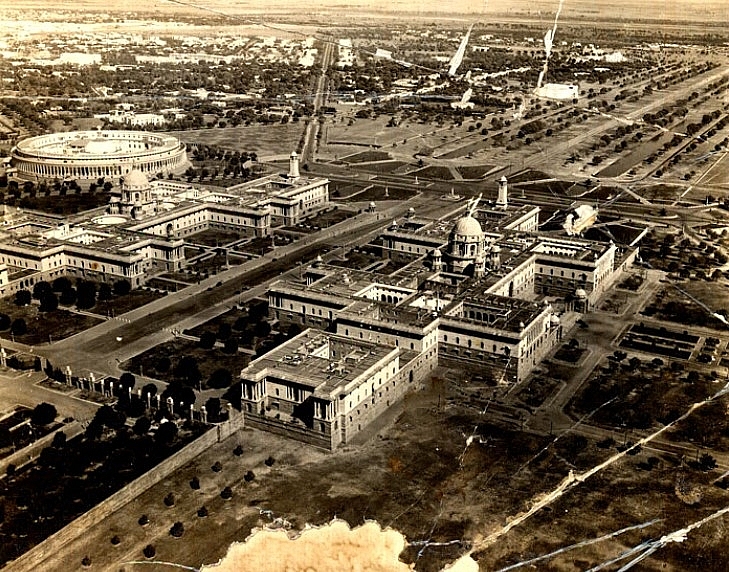 |
| Photo: indianculture.gov.in. |
The city has also been under fire in recent years for being one of the most polluted in the world. In 2016, a public health emergency was declared due to a high level of pollution. Several initiatives have been launched to curb the pollution, including banning vehicles over 10 years old and using taxis that use compressed natural gas.
Today, the city has been selected under the Smart Cities Mission to be developed as a smart city.
Best Places to See in New Delhi
Delhi, the capital of India, has a rich history. The city is dotted with spellbinding mosques, forts, and monuments left over from the Mughal rulers that once occupied the city. The contrast between rambling Old Delhi and well planned New Delhi is immense, and it's interesting to spend time exploring both. If you feel in need of some relaxation, just head to one of Delhi's flourishing landscaped gardens.
A trip to the capital wouldn't be complete without seeing the following attractions:
India Gate
According to thrillophilia.com, India Gate is an important site to visit when on your tour to Delhi. India Gate has its original name as All India War Memorial that was built in order to commemorate the 82000 soldiers of the Indian Army who lost their lives during the First World War happened from 1914 to 1921 as well as in the Third Anglo-Afghan War. The war memorial is situated at Rajpath where you can reach by getting down at Barakhamba Road Metro station in Delhi. India gate is also known to be one of the best places to visit with friends in Delhi.
India Gate is located on the eastern edge of the ceremonial axis of Delhi and it was formerly called Kingsway. The names of around 13300 servicemen including some soldiers and officers from the United Kingdom are displayed on the gate. The architecture of India Gate is world famous as the triumphal arch that looks like the Arch of Constantine and also compared to the Arc de Triomphe and the Gateway of India in Mumbai.
The designer of the memorial was Sir Edwin Lutyens. After the Bangladesh Liberation War in 1971, there was a simple structure including a black marble plinth with a reversed rifle which was capped by a war helmet and bounded by four eternal flames built under the Memorial Archway. This one was the Amar Jawan Jyoti or the Flame of the Immortal Soldier.
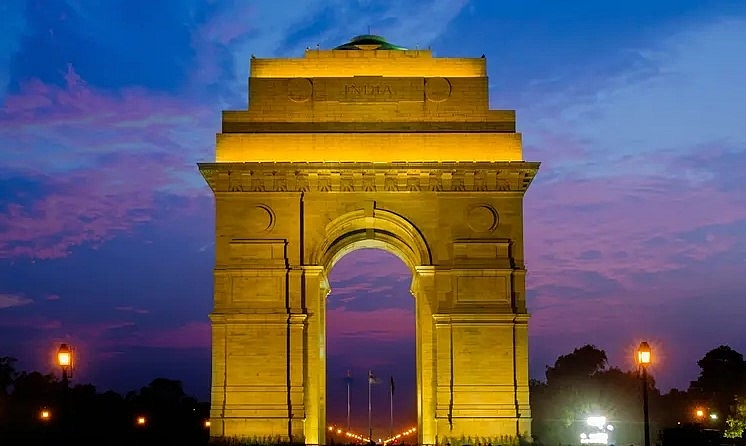 |
| Photo: thrillophilia.com. |
The construction of India Gate was started in 1921 and completed in 1931. The architectural dimensions of the structure say that it is 42 meters tall and 9.1 meters wide. It was constructed using yellow and red sandstone along with granite. In 2014, the Government announced the plans to construct a National War Memorial around the canopy as well as a National War Museum at the park nearby.
India Gate Parade or the Republic Day Parade is the most ceremonious and prestigious event happen in front of India Gate every year. On January 26th, each year, India commemorates the day it became a republic with an esteemed presence of many national as well as dignified guests from other countries.
| Tips: -The climate during the months from October to March will be favourable for sightseeing tours in Delhi. You can enjoy visiting India Gate with your family and friends peacefully during that time. -It will be fun if you bring cooked or packaged food with you, and have a picnic. You can also go for boating at the Boating Club adjacent to India Gate grounds. -The nearest metro station to India Gate is Central Secretariat (Yellow Line). The metro station has more than one exit gate so that you can seek the help of customer service about the closest gate to India Gate. -Take an auto rickshaw or the shuttle rickshaw/rickshaw service to India Gate from the metro station. Bus service can also be availed depending on your boarding point. -In case you are there in January, you can attend the Republic Day parade on 26th January. India Gate entry time: Anyone can visit India Gate anytime as it is open on all days 24 hours. India Gate Entry fee: There is no entry fee to visit the structure. India Gate location: Rajpath Marg, India Gate, New Delhi, Delhi 110001. |
Humayun's Tomb
As the name suggests, Humayun's tomb is the final resting place of the Mughal Emperor Humayun. Located in the Nizamuddin East area of Delhi, it is the first garden-tomb in the Indian subcontinent. This splendid piece of architecture was commissioned for construction by Humayun's chief consort Empress Bega Begum in the year 1569-70 and is one of the very few structures that used red sandstone on such a massive scale at that time. The design of Humayun's tomb is a typical Mughal architecture with Persian influences and was conceptualised by Persian architect Mirak Mirza Ghiyath. Owing to its magnificent design and illustrious history, Humayun's Tomb was featured in UNESCO's World Heritage List in the year 1993.
As holidify.com reported, the architectural genius of Humayun's tomb is hard to miss. This magnificent tomb sits in the middle of a huge, ornate Mughal Garden and its beauty is only enhanced during the winter months. Situated on the banks of the River Yamuna, this mausoleum is also home to the remains of many other Mughals, including his wives, son and descendants of the later Emperor Shah Jahan, as well as numerous other subsequent Mughals.
The Red Fort
According to planetware.com reported, the beautiful Red Fort (Lal Qila) was built by Shah Jahan in 1648 and served as the seat of Mughal power until 1857. This stunning structure, with its tall, red sandstone walls covers an area of more than two square kilometers, the entirety of which is crescent shaped and surrounded by a moat.
The impressive main entrance, the Lahore Gate, is so named as it faces towards Lahore in Pakistan, while the even grander Delhi Gate was used by the emperor for ceremonial processions. Entering through the Lahore Gate, visitors reach Chhatta Chowk, a 17th-century covered bazaar where items such as silks, jewelry, gems, and silverware can be purchased, along with souvenirs and food items.
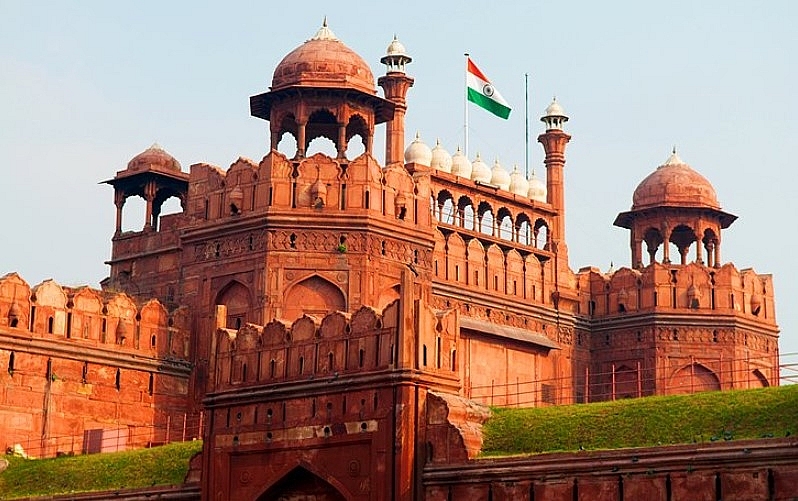 |
| The Red Fort. Photo: planetware.com. |
The Naubat Khana within the Red Fort once housed the musicians who played for the emperor, and its fine galleries still contain many interesting musical instruments such as kettledrums, gongs, and cymbals. Diwan-i-Am, the Hall of Public Audiences, where the emperor would receive his subjects, is also worth seeing for its stunning white marble.
Lodhi Gardens
According to tripsavvy.com, Lodhi Gardens provides a serene retreat from city life, and is the place to come if you're feeling tired and worn out. The vast Gardens were built by the British in 1936 around the tombs of 15th and 16th century rulers. Joggers, yoga practitioners, and young couples all enjoy this park.
Location: Lodhi Road, not far from Humayun's Tomb.
Entry Cost: Free.
Opening Hours: Daily from sunrise until 8 p.m., but Sundays are particularly busy.
Akshardham Temple
Dedicated to Bhagwan Swaminarayan, Akshardham Temple exhibits the ancient culture of India. The temple complex maintains a step-well styled courtyard and 60 acres of lush lawns featuring the bronze statues of Indian heroes, including patriots and warriors. Registered as the World’s largest comprehensive Hindu temple in the Guinness World Record, the temple is an architectural marvel built from intricately carved sandstone and marble. Furthermore, the temple organizes exhibitions on Swaminarayan’s life teachings and also organises a musical fountain and light show after sunset every day, fabhotels.com reported.
Timings: 09:30 am to 06:30 pm
Entry Fee: INR 170 (Adults); INR 100 (Children)
Nearest Metro Station: Akshardham, New Delhi
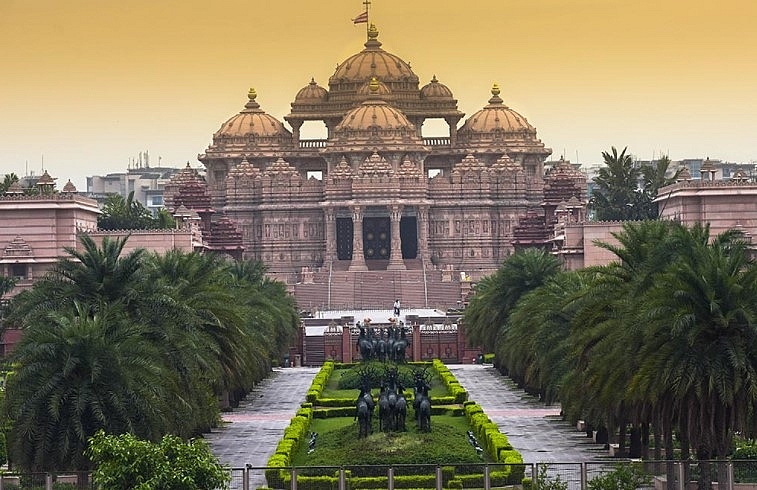 |
| Akshardham Temple. Photo: fabhotels.com. |
Hauz Khas
Hauz Khas is a beautiful neighbourhood of South Delhi and is one of the major tourist places in Delhi. The pulse of Hauz Khas is known to be the historically important Hauz Khaz Complex. It exhibits both rural and urban atmosphere and also known as mehak ka chota quila. The location is surrounded by Green Park to the west and Gulmohar Park towards the north. It had witnessed different diplomatic missions like the Albania, Iraq, Guines, Burundi, Macedonia Missions and more.
Its name started achieving appreciation from the outer world due to the presence of an ancient water reservoir by the same name. It is now part of the huge Hauz Khas complex. Hauz means water tank in Urdu and Khas is referred to royal and thus it is considered to be the royal tank in the village. Hauz Khas’s water tank was built firstly by Allauddin Khilji in order to supply water to the inhabitants of Siri Fort and later in the 1960s, it was developed by the famous builders in India, DLF.
| Hauz Khas entry fee: There is no entry fee is applicable. Hauz Khas location: Hauz Khas, South Delhi, Delhi 110016, India. Tips: -Hauz Khas fort is a major attraction here and try not to avoid it. -Hauz khas social is café-cum-restaurant-cum-co-working space. -Experience the best nightlife in Delhi by visiting the different shops and restaurants. |
Gurudwara Bangla Sahib
Delhi's most important Sikh place of worship, the 18th-century Gurdwara Bangla Sahib is located near Connaught Place and is well worth a visit. Highlights include its magnificent pool, the Sarovar, at the heart of this large complex, as well as its famous gold dome and flagpole.
Also of note is the large temple building itself, along with its art gallery and a small museum dedicated to the history of the Sikh religion. Visitors are always welcome here, and an excellent meal is available at no cost in the large Gurdwara Kitchen. All that is asked in return is your hair be covered and shoes removed (free headscarves and shoe storage are provided).
Address: Ashoka Road, Hanuman Road Area, Connaught Place, New Delhi, Delhi, India
Qutab Minar
A valuable, protected structure of India is Qutub Minar, Delhi which has been considered to be a highly important historical attraction existing currently in India. It is a part of the Qutub Complex which was declared as a UNESCO World Heritage Site and it is also one of the famous places to visit in north Delhi. The structure is situated in the Mehrauli area of Delhi. Qutub Minar Metro Station located at a distance of about 3km will be the easiest access to reach the amazing architectural brilliance. You can also book Delhi tour package as here is no end to the glorious history being explored in the present.
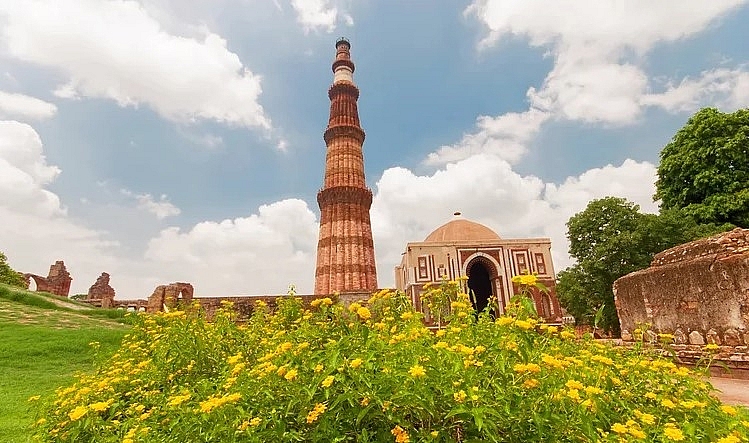 |
| Photo: thrillophilia.com. |
Qutub Minar is made of red sandstone and marble making its height up to 73 meters and gives a tower like structure to it which is consisted of five stories and its diameter is 14.3 meters at the base and it becomes 2.7 meters at the top.
Another main feature of it is the spiral staircase of 379 steps. It has been saying that the design of the tower had its origin from the Minaret of Jam located in Western Afghanistan. Qutub Minar’s founder was the legendary Qutub al-Din Aibak who was behind the existence of the Delhi Sultanate. The construction of the structure was started in 1192 and it was completed by Aibak’s successor Iltumish in 1220. But after some decades, its top storey was destructed by a lightning and later Firoz Shah Tughlaq renovated the damaged storey and constructed one more.
Appu Ghar, Gurgaon
A rainforest-themed water park, Appu Ghar Water Park is bringing back the old charm with its newly launched Oyesters Water Park. Spread over an area of 10 acres, it offers 16 innovative rides like Sky Fall, Whirl Wind, and Rapid Racers, including India’s tallest 93 feet slide and first free fall ride. Additionally, the park maintains banquet facilities for up to 3,500 guests, and has an amazing food court offering refreshing mocktails and mesmerizing dining options.
Timings: 11:00 am to 7:00 pm
Entry Fee: INR 799 (Kids); INR 1299 (Adults)
Nearest Metro Station: Huda City Centre, Gurgaon
Bahai (Lotus) Temple
Known for its unique architectural design, Lotus Temple is a Bahá’í House of Worship, dedicated to harmony of humanity. Inspired by the lotus flower, the temple boasts of 27 free-standing marble-clad petals, and is surrounded by sprawling gardens and pond. With a height of over 34 metres, it can accommodate around 2500 people altogether. The temple welcomes every religion symbolizing the culture of Bahá’í Houses of Worship, and offers a tranquil ambience ideal for rejuvenation.
Timings: 9:00 am to 5:00 pm
Nearest Metro Station: Kalkaji Mandir, New Delhi
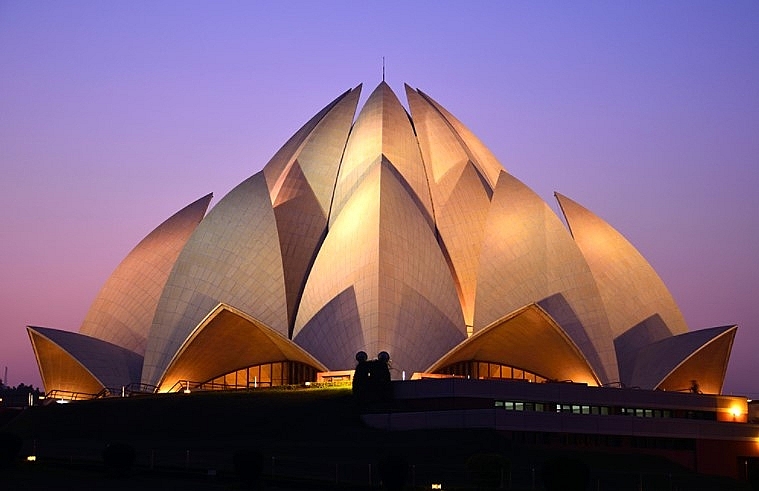 |
| Lotus Temple. Photo: fabhotels.com. |
Interesting Facts about New Delhi
Here are some interesting facts that we summed up from stanzaliving.com, brbgonesomewhereepic.com and holidify.com.
The Red Fort was Originally White
Red Fort is one of the best things about Delhi, especially if you love history. But did you know this monument was not always red in colour? According to the Archaeological Survey of India, it was actually made of white limestone and when the colour started chipping off, some British officials decided to paint it red.
Delhi and New Delhi are Technically Two Different Places
New Delhi is officially India’s capital, whereas Delhi is the name for the surrounding region, the NCT (National Capital Territory of Delhi), of which New Delhi forms a small part of.
Tallest Minaret in the World
If you search for information about New Delhi on the internet, you won’t find a single place that doesn’t mention Qutub Minar. After all, it is not only a special historical monument but also the tallest brick minaret in the whole world. It was built way back in 1200 AD, but the Minar stands “tall” even today.
Asia’s Largest Spice Market
Even though it’s situated really close to the Red Fort, there are high chances that you might not have heard of this one. Khari Baoli, Asia’s largest spice market, started somewhere in the 17th century and continues to be a bubbly marketplace to date. Do visit this market if you want to spice up your food (or your knowledge about Delhi). Quite literally.
Asia’s Largest Wholesale Market for Fruit and Vegetables
Speaking of Asia’s largest markets, Delhi has another one of them. The Azadpur wholesale is the largest fruit and vegetable market in all of Asia. If you love fruits, this is the place to be. From local produce to international varieties of kiwi, Alphonso mango, peach, you will find everything here. And for the ones who have chosen the organic life, you’ll find plenty of options too. Just for a few extra bucks.
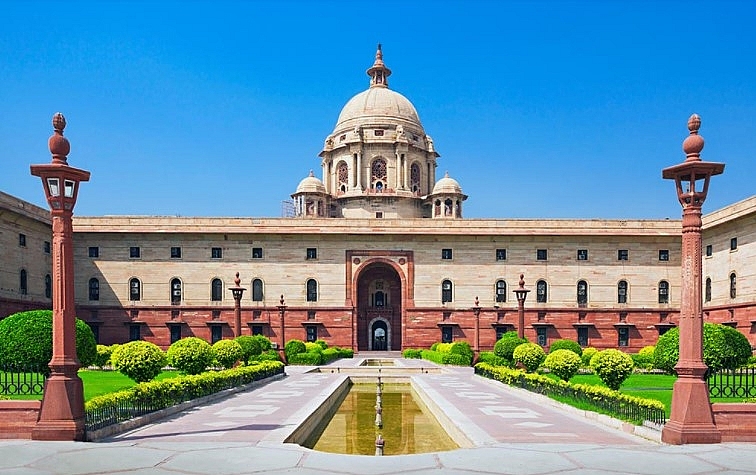 |
| Rashtrapati Bhavan. Photo: fabhotels.com. |
Winter Generally Begins in November and Peaks in January
However, summers in New Delhi are long – beginning in April and lasting through to October.
Home to the World’s Tallest Brick Structure: The Qutub Minar
This Mughal landmark, which stands at 73 metres tall, is one of the most popular tourist spots in the city.
Only Bahai Temple in Asia
If you already didn’t know this about Delhi, let us tell you that the city houses the only temple dedicated to the Baha’i religion in Asia. In fact, Lotus Temple is one of the eight Bahai temples in the entire world. It’s open to people of all religions and is no longer just a place of worship anymore. It’s a place you can come to meditate, date or simply take some aesthetic pictures.
Five of the Original 14 Gates of the Walled City of Delhi are Still Standing
These include: Lahori Gate – facing Lahore in Pakistan, Delhi Gate – pathway to earlier cities in the state, The Ajmeri Gate – facing Ajmer in Rajasthan, Kashmiri Gate – facing north to Kashmir, and the Turkman Gate – named after the religious Saint Hazrat Shah Turkman.
Most Expensive Office Space in India
Well well well. If you’re thinking of leasing space to start your own office here, maybe…think again? Connaught Place is the most expensive in terms of office spaces in India, and the 9th most expensive in the world. While as a whole, the rent around the city is a little lesser than cities like Mumbai, do not make the mistake of choosing a space in CP if you don’t want to spend all your capital on paying rent in the capital.
Delhi is the leading commercial center of India
Being the capital of the country, Delhi is one of the leading commercial centres within the northern part of India. Along with the manufacturing and sales, Delhi also has vast and rapidly growing retail industries.
Delhi is home to a unique Museum of Toilets
As ludicrous as this fact about Delhi sounds, the museum of toilets offers a perfect message on the history of sanitation. It is known as the Sulabh international museum and is managed by Sulabh International, which aims to spread the word of hygiene across the globe. The museum was established in 1992 by Dr Bindeshwar Pathak.
| Frequently Asked Questions about India How should I dress when visiting religious sites (i.e. temples)? If you want to be respectful and also not stand out like a sore thumb, heed the words of Sankara who runs Be on the Road, “Different temples in India have different dress codes. Some require you to cover your head (at the Mosques, Dargahs and Sikh Gurudwaras), while other require men to be topless (orthodox South Indian temples). According to tourrada.com, the safest option while dressing for a temple visit in India is to cover your shoulders and knees. A loose fitting dress for a woman or the Indian Salwar Kameez and a simple shirt/t-shirt and pants for the man would take you into most religious places.” What is the average cost for accommodation? Accommodation cost varies depending on the luxury you prefer while travelling. It can start from 1,000 rupees (basic) to any range, depending on the place and services. What are the styles of toilet like? Western style public toilets are most easily found in major cities and tourist sites; the cleanest are often at modern restaurants, shopping complexes and mid-range/top-end hotels. In ultra-cheap hotels and places off the tourist trail, such as small towns and villages, squat toilets / Indian style toilets are the norm and it is usually not common to find toilet paper, so it is always a good idea to carry your own toilet paper and hand sanitizer, just in case. What are some basic words in Hindi to help me get by? The basic Hindi words that can help you while exploring India are: Namaste – Hello Dhanyavaad – Thank You App Kaise ho? – How are you? Mein achi hu – I am good What languages are spoken in India? Is English commonly used? India has 2 official languages at the national level – English and Hindi (spoken by 40% of India). Most road signs, menus, advertising and tickets are a few examples of where English script is used to communicate. It’s a rare day that travellers are caught unable to speak in English with most people they come in contact with, especially in the big cities. |
 What Is The Capital of Austria: History, Facts, Best Places to See What Is The Capital of Austria: History, Facts, Best Places to See What is the Capital of Austria? A city that inspires with the old and the new alike, and always has a cosy place available in ... |
 What Is The Capital of New Zealand: History, Facts, Best Places to See What Is The Capital of New Zealand: History, Facts, Best Places to See Wellington is the capital city and second most populous urban region of New Zealand. We rounded up all things you need to know about its ... |
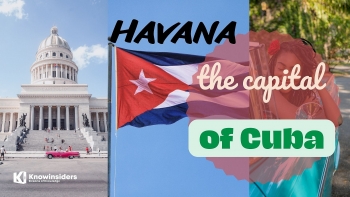 What Is the Capital of Cuba: History, Facts, Best Places to See What Is the Capital of Cuba: History, Facts, Best Places to See Cuba’s capital is a beautiful city where the streets are decorated with colorful houses, classical cars and artists. We rounded up all things you need ... |


